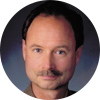| Dr. Menke teaches the Integrative Chiropractic postgraduate course series for chiropractors through National University of Health Sciences, and teaches medical professionals about chiropractic through the University of Arizona Program in Integrative Medicine.
|
"Cynicism is the disease of our times." - Carlos Castaneda
The concepts of skepticism and cynicism may appear similar, but their differences are crucial for an emerging profession such as chiropractic. Both describe doubt. Skepticism is often attached to the word "healthy," as in "healthy skepticism." Cynicism drifts into bitter passivity and creates a "victim" attitude. Skepticism discovers; cynicism covers up. Skepticism embraces the light; cynicism curses darkness.
Since the 1950s, science has enthusiastically hinted at 120-year lives, cures for cancer, colonies on Mars, travel to the moon, and deserts blooming. Religion and prayer seemed impotent by comparison. Science became a new religion; a place of certainty, optimism, and control.
Today, hearts and intervertebral disks are replaceable with gizmos. But beyond the flashy headlines and optimism of a technological solution for every problem, we still find self-healing and prevention are superior "technologies." Robert Tools, implanted with the first self-contained artificial heart, was not too impressed when public attention faded and he faced death five months later. Chiropractors have always questioned the value of technology as the only solution to all our health problems.
Clinicians lead; scientists follow. If clinicians report results, scientists should get curious. During the 2003 chiropractic workshop at the University of Arizona Program in Integrative Medicine, one MD suggested chiropractors have been too hard on themselves. The doctor noted, for example, that although chiropractic management does not cure asthma,1 neither does medicine. Quality-of-life indicators have improved under chiropractic, but without the side-effects of inhalers and prednisone. The MD then asked, "Why aren't chiropractors proclaiming comparable efficacy to medical management, but without the side-effects?" This is an interesting question coming from outside our profession.
Healthy skepticism in a chiropractor is vital for evaluating chiropractic and medical procedures; our profession has now reached the maturity to ask the tough questions. In the past, trouble arose when one or a few cases got better as a result of chiropractic care, or coincident with chiropractic supervision. Claims were made before science was applied. Science is precisely the work of sorting cause from coincidence. Research is a solid foundation for integrative medicine - serving in health care delivery as an equal. Integrative medicine would enable us to get five to 10 times the patients we currently obtain, through things such as physician referrals.2 Many of these would be patients not improving under a different model of health care, and looking for a true "second opinion."
To be integrative, chiropractors should be skeptical of all healing procedures, including medical ones. But cynicism is destructive to integration. Cynicism aimed internally asserts chiropractic has little to no value. Aimed at medicine, it declares chiropractors will not get the respect they deserve. In short, it shoots us - or them.
Skepticism arises from genuine curiosity, and requires evidence. Cynicism in a profession accustomed to being under siege may result from perceiving science as the profession's master, rather than its powerful servant. But the call to science is a privileged responsibility eventually encountered by every profession worth investigating. It is acknowledgement that chiropractic has arrived at an elite status, and is secure enough to submit to scientific scrutiny. How often in a lifetime can we observe a profession at this threshold? Probably less than once in several generations.
Restoring health probably is, as chiropractors have maintained, more than a "technical intervention." Ultimately, healing is not simply dispensed from a bottle. We offer a somatic invitation; a gentle reminder that homeostasis is preferable to the chaos of disease. As science brings healing under the microscope, cherished notions will be discarded, but replaced by better ones, to produce finer chiropractors.
As I teach other health care professions about manual medicine and chiropractic, I see that we offer a perspective and methodical approach unique and valuable to consumers and health care. But when cynicism masquerades as clever skepticism or objective science, it thwarts the promise and potential of not just chiropractic, but all of manual medicine.
References
- Balon J, Aker PD, Crowther ER, Danielson C, Cox PG, O'Shaughnessy D, Walker C, Goldsmith CH, Duku E, Sears MR. A comparison of active and simulated chiropractic manipulation as adjunctive treatment for childhood asthma. N Engl J Med. 1998 Oct 8;339(15):1013-20.
- Menke JM. Principles in integrative chiropractic. J Manipulative Physiol Ther. 2003 May;26(4):254-72.
J. Michael Menke, DC
Palo Alto, California
Click here for previous articles by J. Michael Menke, MA, DC, PhD.





